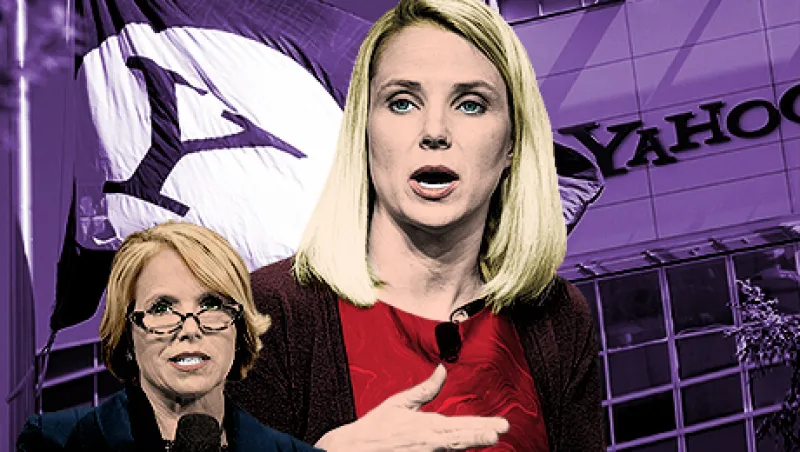Less than 18 months into her tenure at Yahoo, CEO Marissa Mayer can take credit for many changes investors seem to like. A string of bold, high-profile moves ranging from the acquisition of social media site Tumblr (and just recently, content delivery network provider PeerCDN) to the hiring of former television news anchor Katie Couric has rekindled interest in the pioneering Internet company, despite scant improvements on the revenue side. In mid-December Yahoo shares traded just below $40, more than two and a half times the price when Mayer took over in July 2012.
Yahoo’s CEO is buying more than assets aimed at luring traffic to its web sites. The Sunnyvale, California–based software and services company is also conducting an aggressive acquisition strategy targeting its own shares. Since embarking on stock buybacks, Yahoo has repurchased more than 16 percent of its shares. In November the company set aside $5 billion to repurchase more shares.
Buybacks look like sure wins at many companies. They placate shareholders who want cash, fine-tune earnings per share to meet targets, take low-yielding liquid assets off balance sheets and deter hostile suitors eyeing excess cash. What’s more, buybacks bestow these advantages without the risks of engaging in M&A. Because of these virtues and a lack of performance benchmarks, securities analysts and investors seldom apply to buybacks the same level of scrutiny as they do to other large corporate investments.
| Buyback Scorecard The S&P 500 as Stock Repurchasers Best and Worst Programs Industry Comparisons |
News that Yahoo will accelerate stock repurchases is just another sign of unusual times. As broad stock market benchmarks rose to record levels, companies have amped up share buybacks, growing them this year quarter-over-quarter. The third quarter saw some $128 billion in buybacks, pushing the year-to-date total above $344 billion, 15 percent above the first three quarters of 2012. The year as a whole could see $500 billion, close to the highs before the financial crisis.
Since June, buyback announcements at Eli Lilly & Co., IBM, Illinois Tool Works, Microsoft, Qualcomm, Schlumberger, Visa and Yahoo, each in excess of $5 billion, have amounted to $92.5 billion. Add buyback announcements under $5 billion plus ongoing programs at Apple, Merck & Co., Pfizer and Wal-Mart Stores, and prospective repurchases look certain to soar higher next year.
Yahoo came in at tenth place in the third-quarter scorecard, marking steady progress up the buyback ranks, from No. 85 in the first quarter and No. 14 in the second. Buybacks at Yahoo delivered a 64 percent return on investment, best in software and services.
Two factors drive Yahoo’s valuation, says Stifel Nicolaus analyst Jordan Rohan. Investments in Yahoo Japan and the Alibaba Group, a booming Chinese business-to-business web site that links global manufacturers and distributors, tells part of the story. The other part, says Rohan: the pace of share repurchases.
Since initiating buybacks in 2010, Yahoo has increased its market capitalization more than twofold, to $40 billion. The first buyback commenced in June 2010 with a green light to spend $3 billion amid fears that the company had lost its way. Yahoo exhausted the first allotment ahead of schedule, prompting the board to authorize $5 billion more in May 2012.
Yahoo accelerated repurchases in July when Third Point, an activist hedge fund, cashed in 40 million shares at twice the reported cost. Third Point founder and chief executive Daniel Loeb, an erstwhile Yahoo critic who bought shares and joined the board, had pressed for the hiring of Mayer as CEO. With Mayer on board, Loeb then exited the board. Observers speculate that after steep gains and a brief pullback in the share price, Loeb pocketed roughly $600 million. Since then the price of Yahoo shares has continued to ascend, lifting its buyback ROI.
The latest buyback announcement seems to express faith that an expected initial public offering by Alibaba will continue to fuel Yahoo shares. Alibaba was a fledgling Chinese company when Yahoo spotted it in 2005; Yahoo now owns a 24 percent stake. According to Stifel Nicolaus, Alibaba could reach a $191 billion market value in three years or less, more than triple the expectation two years ago.
Propelled by a surging stock market, companies that repurchased shares notched a median 28.4 percent buyback ROI in the third-quarter scorecard. In comparison, first- and second-quarter buyback ROI ran at 24.1 percent and 19.4 percent, respectively. The vast majority of companies posted positive buyback ROI, not surprising in a bull market.
“Companies are taking excess cash and buying shares on the way up,” says John Blank, chief equity strategist for Zacks Investment Research. “This may not be the right time, in my opinion, since they don’t have the ability to reverse buybacks if the market declines. But it does speak to a level of bullishness by CEOs about stock trends in the foreseeable future.”
At the same time, buybacks reflect bearish attitudes toward growth. Companies return money to shareholders when they lack better ways to invest it. Collectively, buybacks imply and possibly prolong economic weakness.
The trend alarms some economists. “This is exactly the problem,” warns Dean Baker, co-director of the Center for Economic and Policy Research, a liberal Washington think tank. “Companies are seeing record profits, but they see no investment opportunities.” Buybacks or dividends coopt investment at a crucial time, he says, adding, “That is the opposite of what we need right now.”
Typically, buybacks yield less durable share price improvement than revenue growth because price-earnings multiples tend to decline in the wake of large buybacks, says Fortuna Advisors CEO Gregory Milano. In his view, buybacks warrant a top priority only when they capitalize on substantial gaps between the share price and intrinsic value.
In the current buyback sweepstakes, Victor, New York–based wine, beer and spirits company Constellation Brands once again garnered first place, thanks to repurchasing shares ahead of a merger. The spirits distributor correctly predicted the regulatory consequences of Anheuser-Busch InBev’s acquisition of the half it did not yet own of Grupo Modelo, a Mexican brewer. Constellation CEO Rob Sands anticipated that Anheuser-Busch InBev would have to shed assets and snapped up Grupo Modelo’s U.S. beer business, which included domestic rights to its Corona brand, for $4.7 billion. The deal was shrewd, and it unfolded as planned, says analyst Timothy Ramey, who covers Constellation for D.A. Davidson & Co. Constellation’s stock price soared.
Celgene also repeated in the top group. The Summit, New Jersey–based biopharmaceutical company funneled nearly $4.7 billion into stock repurchases in the third quarter. Deutsche Bank analyst Robyn Karnauskas gives much of the credit for the aggressive buyback strategy to Jacqualyn Fouse, Celgene’s CFO since September 2010. “Buybacks have just emphasized her conviction that guidance will be met and that the company will grow revenue and earnings,” Karnauskas says.
Four companies from diverse sectors joined the top-ten list for the first time: Cigna, a Bloomfield, Connecticut–based health care services company; McLean, Virginia, media conglomerate Gannett Co.; Radnor, Pennsylvania–based insurer Lincoln National Corp.; and Yahoo.
Cigna led the newcomers, taking third place on the Corporate Buyback Scorecard. Buybacks in the third quarter edged past 4 percent of Cigna’s market value, a threshold for inclusion on the scorecard. Since then, Cigna has also passed the $1 billion threshold.
Stock buybacks at Cigna have delivered a hefty 76 percent ROI. Success like that attracts attention. Far from the afterthought of former days, buybacks get high priority when it comes to deploying capital, says vice president of investor relations Ted Detrick. “First, we fund organic growth. Beyond that, we look to fund strategic M&A. Absent that, it’s a buyback.”
Buyback ROI at Cigna looks more impressive still in the light of buyback effectiveness, a computation that shows the extent to which buyback ROI outperforms or underperforms underlying total shareholder return. Buyback effectiveness is different from tallying an average cost for repurchased shares and then looking at the price at the end of the period. If shares moved in a straight line, all that would matter for purposes of calculating an internal rate of return is the price trend, says Fortuna Advisors senior associate Joseph Theriault. Because companies typically buy shares at different points in time, interim share-price volatility enters the calculation.
If, for instance, a company buys back most of its shares at price peaks over two years, cash outflows will be much higher — or the number of cumulative shares repurchased will be much lower — than if it repurchases stock at lows. Buyback effectiveness measures the extent to which a company repurchases shares above or below the price trend. Buying low improves buyback ROI; buying high erodes it.
Companies want buyback ROI to outpace total shareholder return. Cigna accomplished this by 2.5 to 1 — the best ratio among the top ten companies — without trying to time the market. “It’s not our approach to build up capital and wait for a stock correction as a primary basis for share repurchases,” Cigna’s Detrick says. Instead, at intervals, Cigna weighs the various ways it can deliver ROI to shareholders. When Cigna rules out using the capital for other purposes,it repurchases shares through daily, open-market purchases up to a percent of daily trading volume, not subject to market strength or weakness.
Robust buyback effectiveness is good but doesn’t guarantee top-tier buyback ROI. Houston- and Dubai-based oilfield services giant Halliburton delivered the highest buyback effectiveness but ranked 41st in buyback ROI.
Companies near the bottom of the scorecard saw considerable turnover. On the rise were Altera Corp., Apple, Cliffs Natural Resources, Dell (undergoing the ultimate buyback scenario, a buyout led by founder Michael Dell), Devon Energy and Juniper Networks. Falling were Allergan, Broadcom, Intuitive Surgical and the Mosaic Co. (Mosaic’s performance reflects buybacks tied to its M&A activity). After languishing in the basement in first- and second-quarter scorecards, Apple soared 82 places, to No. 183, posting buyback ROI of 19.5 percent driven by a 12 percent gain in the stock price.
Losers failed to cash in during the best of times for the stock market. Intuitive Surgical replaced Cliffs Natural Resources at the bottom of the rankings. Intuitive Surgical’s buyback program dates to March 2009, when its board authorized up to $300 million in buybacks. Subsequent approvals allowed the company to repurchase shares worth $1.3 billion through the third quarter, or 9 percent of its market cap at year-end 2011.
The company reported that early buybacks fared well as Intuitive Surgical stock rose smartly. Over the past two years, however, they look very different. Collectively, they’ve taken a 37 percent hit, akin to undoing a merger by surrendering assets for less than two thirds of the purchase price. Buyback effectiveness was even worse, at negative 39 percent, also the worst in the ranking. Management not only embarked on a buyback strategy but also executed repurchases at the wrong times.
In fairness to Intuitive Surgical and Edwards Lifesciences, another medical technology company languishing in the bottom ten, options for spending excess cash are scarce. “The number of quality acquisition targets relative to the number of companies seeking them has changed valuation ratios dramatically in recent years,” says Ben Andrew, who follows both companies for William Blair & Co. “I would rather management give the money back to shareholders than make a stupid acquisition.”
Still, dismal buyback ROI reflects on a management team that should have a firmer grip on its own business prospects. But proximity can impair buyback judgment. Intuitive Surgical proved to be unduly optimistic during a challenging period. Time may eventually validate its buybacks, but Intuitive’s track record doesn’t build confidence. “When they were making buyback decisions,” says Andrew, “they thought the business was stronger than it turned out to be.” That was a mistake shareholders are paying for now.






